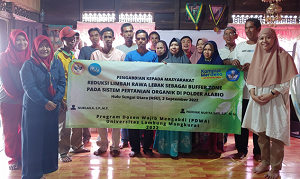Pengenalan Konsep Buffer Zone di Desa Teluk Sinar, Kabupaten Hulu Sungai Utara Introducing Buffer Zone Concept in Teluk Sinar Village, North Hulu Sungai Regency
Main Article Content
Abstract
A buffer zone is an area designated to protect a conservation area from being disturbed by the surrounding environment. The concept of a buffer zone can be adopted to protect an area or land from contamination by factories, household, and agricultural waste. Teluk Sinar Village is a village located in a freshwater swamp area where there are mines around this area. Further, agricultural practices in the area still use chemicals that leave residues and can pollute the environment, including water pollution. The problem partner is the low level of knowledge about the impact of water pollution on organisms, including human health. Through this community service, it will be a solution to understanding the effects of water pollution for members of the Bunga Seroja Farmer Group through the concept of buffer zone technology. The community service was conducted by the lecture method and gave a pocket book. It significantly increases the knowledge and understanding of farmers about the buffer zone concept.
Downloads
Article Details

This work is licensed under a Creative Commons Attribution-ShareAlike 4.0 International License.
Authors who publish with this journal agree to the following terms:
- Any article on the copyright is retained by the author(s).
- Author grant the journal, right of first publication with the work simultaneously licensed under a Creative Commons Attribution License that allows others to share work with acknowledgment of the work authors and initial publications in this journal.
- Authors are able to enter into a separate, additional contractual arrangements for non-exclusive distribution of published articles of work (eg, post-institutional repository) or publish it in a book, with acknowledgment of its initial publication in this journal.
- Authors are permitted and encouraged to post their work online (e.g., in institutional repositories or on their websites) prior to and during the submission process, as can lead to productive exchanges, as well as earlier and greater citation of published work.
- The article and any associated published material is distributed under the Creative Commons Attribution-ShareAlike 4.0 International License
References
Affandi, F. A. & Ishak, M. Y. (2019). Impacts of suspended sediment and metal pollution from mining activities on riverine fish population—a review. Environmental Science and Pollution Research, 26, 16939-16951. https://doi.org/10.1007/s11356-019-05137-7
Amiri, B. A. & Nakane, K. (2008). Entire Catchment and Buffer zone Approaches to Modeling Linkage Between River Water Quality and Land Cover — A Case Study of Yamaguchi Prefecture, Japan. Chinese Geographical Science, 18(1), 85-92. https://doi.org/10.1007/s11769-008-0085-6
Babu, S. M. O. F., Hossain, M. B., Rahman, M. S., Rahman, M., Ahmed, A. S. S., Hasan, M. M., et al. (2021). Phytoremediation of Toxic Metals: A Sustainable Green Solution for Clean Environment. Applied Sciences, 11(21), 10348. https://doi.org/10.3390/app112110348
Banuwa, A. K. & Susanti, A. N. (2021). Evaluasi Skor Pre-Test dan Post-Test Peserta Pelatihan Teknis New SIGA di Perwakilan BKKBN Provinsi Lampung. Jurnal Ilmiah Widyaiswara, 1(2), 77-85. https://doi.org/10.35912/jiw.v1i2.1266
Dersseh, M. G., Melesse, A. M., Tilahun, S. A., Abate, M., & Dagnew, D. C. (2019). Chapter 19 - Water hyacinth: review of its impacts on hydrology and ecosystem services—Lessons for management of Lake Tana. In: Melesse, A. M., Abtew, W., & Senay, G. (eds) Extreme Hydrology and Climate Variability: Monitoring, Modelling, Adaptation and Mitigation. Elsevier, Amsterdam. 237-251. https://doi.org/10.1016/B978-0-12-815998-9.00019-1
Duque, G., Gamboa-García, D. E., Molina, A., & Cogua, P. (2020). ffect of water quality variation on fish assemblages in an anthropogenically impacted tropical estuary, Colombian Pacific. Environmental Science and Pollution Research International, 27(20), 25740–25753. https://doi.org/10.1007/s11356-020-08971-2
Effendy, I. & Hamid, M. A. (2016). Pengaruh Pemberian Pre-Test dan Post-Test Terhadap Hasil Belajar Mata Diklat HDW.DEV.100.2.A pada Siswa SMK Negeri 2 Lubuk Basung. VOLT: Jurnal Ilmiah Pendidikan Teknik Elektro, 1(2), 81–88. http://dx.doi.org/10.30870/volt.v1i2.2873
Herawati, H., Yulianto, E., & Azmeri. (2020). Pengaruh Hidrotopografi dan Peruntukan Lahan Terhadap Saluran Tersier Daerah Rawa Pinang Dalam. Jurnal Saintis, 20(1), 1-10. https://doi.org/10.25299/saintis.2020.vol20(01).4698
Jafari, N. G. & Trivedy, R. K. (2005). Environmental pollution control by using phytoremediation technology. Pollution Research, 24(4), 875–884.
Muscutt, A. D., Harris, G. L., Bailey, S.W., & Davies, D. B. (1993). Buffer zones to improve water quality: a review of their potential use in UK agriculture. Agriculture, Ecosystems and Environment, 45(1-2), 59-77. https://doi.org/10.1016/0167-8809(93)90059-X
Mahmud, N. U. (2021). Studi Pengembangan Lahan Rawa Lebak Polder Alabio Hulu Sungai Utara Kalimantan Selatan. Paduraksa: Jurnal Teknik Sipil Universitas Warmadewa, 10(1), 13-24. https://doi.org/10.22225/pd.10.1.2242.13-24
Nava-López, M. Z., Diemont, S. A. W., Hall, M., & Ávila-Akerberg, V. (2016). Riparian Buffer zone and Whole Watershed Influences on River Water Quality: Implications for Ecosystem Services near Megacities. Environmental Processes, 3, 277–305. https://doi.org/10.1007/s40710-016-0145-3
Ou, Y., Wang, X., Wang, L., & Rousseau, A. N. (2016). Landscape influences on water quality in riparian buffer zone of drinking water source area, Northern China. Environmental Earth Sciences, 75, 114. https://doi.org/10.1007/s12665-015-4884-7
Saleh, H. M. (2012). Water hyacinth for phytoremediation of radioactive waste simulate contaminated with cesium and cobalt radionuclides. Nuclear Engineering and Design, 242, 425-432. https://doi.org/10.1016/j.nucengdes.2011.10.023
Shahid, M., Ahmad, A., Khalid, S., Siddique, H. F., Saeed, M. F., Ashraf, M. R., et al. (2016). Pesticides Pollution in Agricultural Soils of Pakistan. In: Hakeem, K., Akhtar, J., & Sabir, M. (eds) Soil Science: Agricultural and Environmental Prospectives. Springer, Cham. 199-229. https://doi.org/10.1007/978-3-319-34451-5_9
Sharma, A., Kumar, V., Shahzad, B., Tanveer, M., Sidhu, G. P. S., Kohli, S. K., et al. (2019). Worldwide pesticide usage and its impacts on ecosystem. SN Applied Sciences, 1(11), 1446. https://doi.org/10.1007/s42452-019-1485-1
